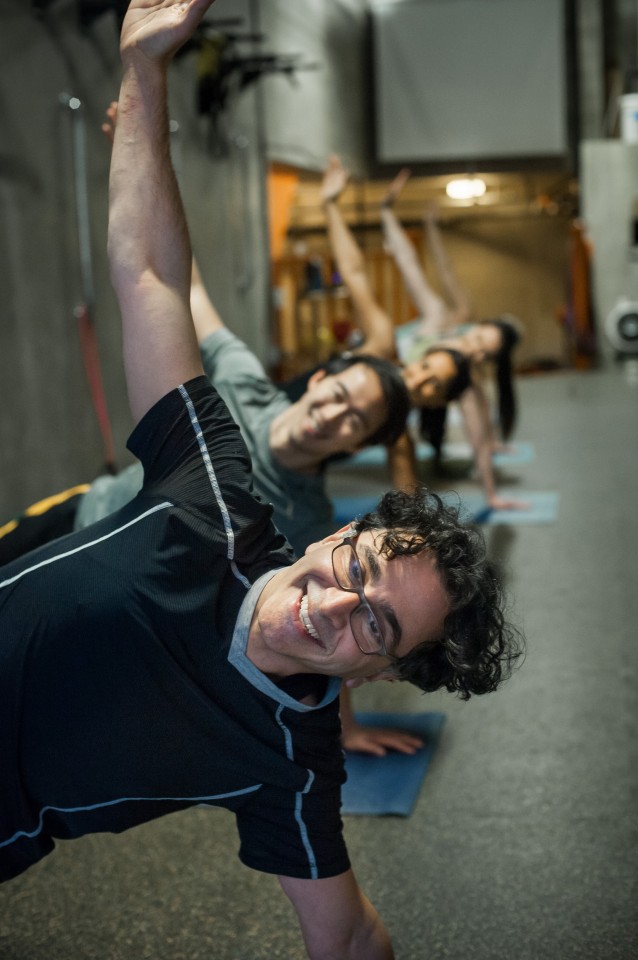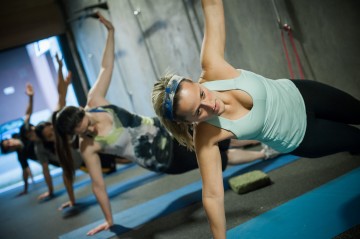
Clinical Professor Kam Shojania (in foreground) leads his residents in a weekly workout. Photo credit: Martin Dee
It has always been a bit of an embarrassment that residency, the period when newly-minted doctors are suddenly immersed in their new roles, also happens to be a particularly unhealthy time for many of them.
A study of 614 residents in a variety of fields, published in the American Journal of Obstetrics and Gynecology, found that doctors-in-training ate fewer meals, ate more high-fat meals, slept less and exercised less than they did before entering residency.
It happened to Kam Shojania when he was a resident. And years later, as Head of the Division of Rheumatology, he noticed it in his trainees.
“I started wondering, ‘Why am I more energetic than the residents who are younger than me?’” says Dr. Shojania, a Clinical Professor. “They look stressed and tired. And it’s just not right. I’m 20 years older than they are!”
Dr. Shojania also didn’t like what he saw among his colleagues: a lot of overweight individuals, walking slowly and tottering, due to weak core muscles and tight hamstrings.
“It’s a shame to see that, because we have to practice what we preach,” he says. “Physicians who exercise themselves are much more likely to recommend exercise to patients.”
“Like methotrexate”
So every Friday afternoon, Dr. Shojania and nearly all of his rheumatology residents convene at a fitness centre near Vancouver General Hospital, to strain, sweat and swear their way to a healthier life.
During one session, a pair of trainers exhorted Dr. Shojania and the residents through a metabolic workout: a series of minute-long drills of pushing, pulling and holding.
“I find it’s like taking medicine — like methotrexate,” says fifth-year resident Mitch Uh. “But methotrexate doesn’t hurt.”
Dr. Shojania hit upon the idea last summer, when he noticed that his residents tended to disappear toward the end of academic days.
“They would say, ‘There’s no way I can learn anything on Friday at four o’clock.’ And I thought, ‘Yeah, you’re right. So we’re not going to learn anything. We’re going to work out.’”
Such programs are rare in medical education, according to a literature review by a third-year UBC medical student who studied Dr. Shojania’s exercise initiative and presented a poster on it at the Canadian Rheumatology Association’s annual scientific meeting in February.
Pain, but gain
Lockhart’s survey of the five participating residents found that they all enjoyed it (appearances to the contrary), and three of the residents said it gave them more confidence in their own ability to prescribe or promote exercise to their patients.
“Now, when I tell residents to explain to back pain patients how to strengthen their core, they know how to do it — they can even demonstrate,” Dr. Shojania said. “Before, that would have been an abstract thing for them. You don’t learn how to strengthen your core in med school.”
All of the residents reported that they were exercising more – beyond the weekly, semi-obligatory sessions – and that their diet, stress levels, sleep habits, mood and learning had improved since beginning the regimen.
“Before this, I wasn’t very good about exercising,” said fourth-year resident Ann Marie Colwill. “It helped to have this scheduled, to make sure we did it.”
The sessions have also contributed to greater camaraderie among the residents, including post-workout drinks at a nearby pub.
“Yes, that does take away some of the health benefits,” Dr. Shojania says. “But it also promotes the idea of physician as collaborator. Here is a way that they can encourage each other.”
